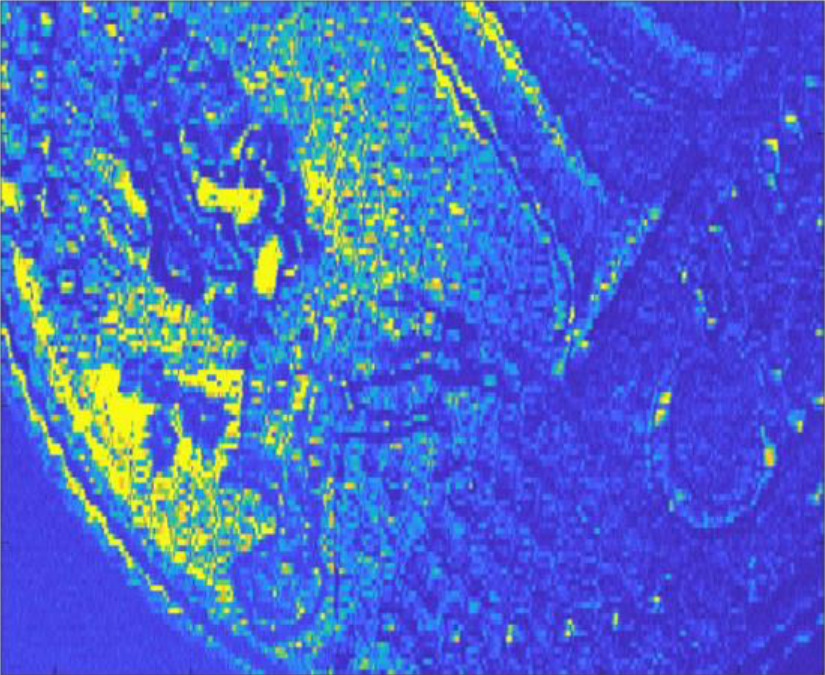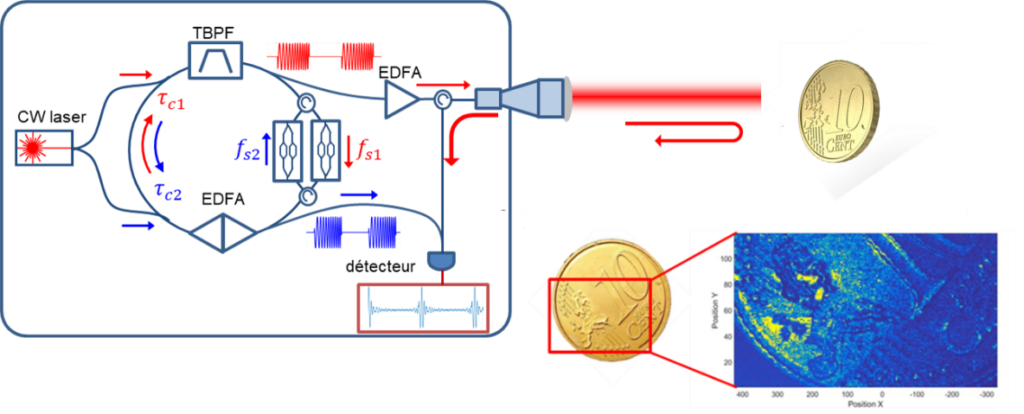Sommaire
Presentation

Lidar (Light Detection and Ranging), is an increasingly widespread imaging technique, especially in the context of the development of autonomous systems (unmanned vehicles, drones) in different fields of application (meteorology, navigation assistance, monitoring, detection, threat detection, etc.) In the DOP team, we are looking to improve existing Lidar techniques by offering new features for increased performance.
Lidar-radar
Compared to conventional lidar techniques, where the distance to the target is deduced from the measurement of the time-of-flight of the light pulse, the lidar-radar offers a number of advantages. It uses a modulated light source instead of laser pulses. It allows velocimetry measurements, and offers the ability to filter the signal by eliminating specific noise components in the return signal. We have developed techniques for generating waveforms adapted to lidar-radar, by frequency-shifted optical reinjection in a Q-switched laser. The pulse-to-pulse coherence of the modulation makes it possible to perform lidar telemetry, as well as velocity measurements. The implementation of this type of laser source at different wavelengths (1 µm and 0.5 µm) allows to consider different aerial and underwater applications.

Coherent dual-comb lidar
Both time-of-flight lidar and lidar-radar are based on the measurement of the intensity of the light returned by the target. In coherent lidar, the electric field of the light is detected, rather than the intensity, which brings other advantages: range in 1/r (instead of 1/r2), ability to measure displacements or speeds with interferometric accuracy, and possibility to filter the signal even at short time scales. The coherent lidar is used for anemometry, among others. The main limitation of coherent lidar is the spatial resolution: to access a high spatial resolution requires to develop coherent and broadband light sources. Multi-heterodyne interferometry (or dual-comb), makes it possible to engineer coherent lidar systems offering a high resolution (sub cm), and with a moderate detection bandwidth. At FOTON Institute, we develop dual-comb architectures from twin frequency shifting loops. One produces the frequency comb of the measurement arm, and the other of the reference channel – or local oscillator. Besides its simplicity, the specificity of this architecture is to be able to produce quasi-continuous waveforms, while maintaining a resolution limited by the spectrum thanks to a pulse compression effect. Configurations using acousto-optic frequency shifters offer a spatial resolution of the order of cm for an ambiguity distance of a few meters, while electro-optic frequency shifters achieve a sub-mm optical resolution for an ambiguity distance of a few tens of cm. The applications of our systems concern high-resolution automatic vision or underwater imaging.

Financial support
ANR (COCOA projetc)
Research staff involved
Research engineers, researchers and professors
PhD and post-doc
To learn more…
- Marc Vallet, Jonathan Barreaux, Marco Romanelli, Grégoire Pillet, Jérémie Thévenin, et al.. Lidar-radar velocimetry using a pulse-to-pulse coherent rf-modulated Q-switched laser.. Applied optics, 2013, 52 (22), pp.5402-10. ⟨10.1364/AO.52.005402⟩. ⟨hal-00854261⟩
- Haiyang Zhang, Marc Brunel, Marco Romanelli, Marc Vallet. Green pulsed lidar-radar emitter based on a multipass frequency-shifting external cavity. Applied optics, 2016, 55 (10), pp.2467–2473. ⟨10.1364/AO.55.002467⟩. ⟨hal-01343399⟩
- Haiyang Zhang, Marc Brunel, Marco Romanelli, Marc Vallet. Green pulsed lidar-radar emitter based on a multipass frequency-shifting external cavity. Applied optics, 2016, 55 (10), pp.2467–2473. ⟨10.1364/AO.55.002467⟩. ⟨hal-01343399⟩
- Juan Clement, Côme Schnebelin, Hugues Guillet de Chatellus, Carlos Fernández-Pousa. Laser ranging using coherent pulse compression with frequency shifting loops. Optics Express, 2019, 27 (9), pp.12000. ⟨10.1364/OE.27.012000⟩. ⟨hal-02102231⟩
- Vincent Billault, Vicente Durán, Carlos R Fernández-Pousa, Vincent Crozatier, Daniel Dolfi, et al.. All-optical coherent pulse compression for dynamic laser ranging using an acousto-optic dual comb. Optics Express, 2021, 29, ⟨10.1364/oe.430998⟩. ⟨hal-03441638⟩